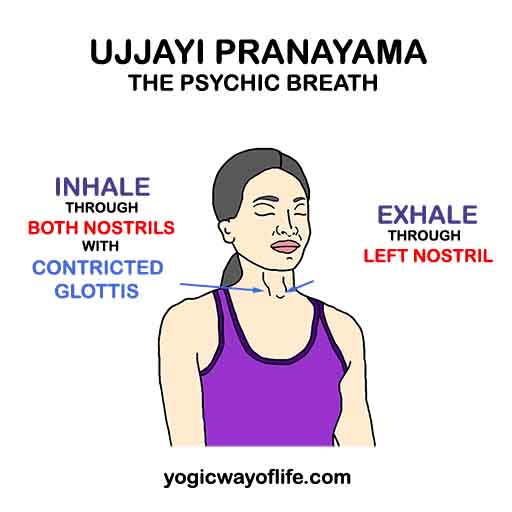Ujjayi Prananaya or the psychic breath soothes the mind and induces a meditative state. Ujjayi means to ‘lift up’. In Ujjayi pranayama, the chest is slightly lifted up as if the inhalation is done from the throat. Ujjayi pranayama is mentioned in the yoga text Hatha Yoga Pradeepika and in the Gheranda Samhita.
Ujjayi involves a deep inhalation from both nostrils with a half closed glottis, so that a faint hissing snoring sound is made during the inhalation. Then there is retention of breath followed by exhalation. Those suffering from heart ailments and blood pressure problems should avoid Kumbhaka or retention of breath. This practice should be learnt from a qualified yoga instructor.
How to do Ujjayi Pranayama?
- Sit in a comfortable meditative pose. Padmasana, Siddhasana, Swastikasana, Sukhasana or Vajrasana can be used. This practice may be even done during light activities like sitting and walking.
- Contract the glottis, so that the passage of the throat is partially closed.
- Roll the tongue up and let the lower side of the tongue touch the upper palate.
- Breathe in slowly through the throat, making a slight hissing snoring sound. During inhalation, the chest is slightly lifted up and the abdomen contracts a little.
- When the inhalation is complete, swallow the breath and perform Jalandhara Bandha (the chin lock).
- Retain the breath inside for as long as you are comfortable. In the initial stages, Kumbhaka or breath retention can be avoided. Add this to the practice when you feel comfortable holding the breath.
- Release the chin lock (Jalandhara Bandha) and exhale through the left nostril (Ida Nadi). Block the right nostril with the right thumb during exhalation. Exhalation may also be done through both the nostrils.
- This is one round of Ujjayi Pranayama. Do as many rounds as you are comfortable.
As one progresses in the practice, increase the time of inhalation and exhalation. Also at some point one can change the ratio of inhalation and exhalation. It can be increased to 1:2. For example, if the inhalation is 4 seconds, then the exhalation can be 8 seconds. One can start the practice with 7 rounds and later increase it depending on the time available. Let each round be continuous without break. Serious practitioners may go up to 320 rounds (in four sittings of 80 each) in a day.
Benefits of Ujjayi Pranayama
- Ujjayi pranayama soothes the nervous system and calms the mind.
- Ujjayi can help those suffering from high blood pressure. But such persons should avoid the retention of breath, unless a doctor advises otherwise.
- Because of its tranquilizing effect on the mind, it is used along with other yogic practices like Kechari Mudra.
- Hatha Yoga Pradeepika claims that Ujjayi pranayama can remove Phlegm in the throat and increase appetite. It destroys the defects in the Nadis, removes dropsy and disorders of the Dhatus (humors).
- The Gheranda Samhita says that a practitioner of Ujjayi pranayama overcomes diseases caused by phlegm, nervous disorders, indigestion, dysentery, consumption, cough, fever and enlarged spleen.

